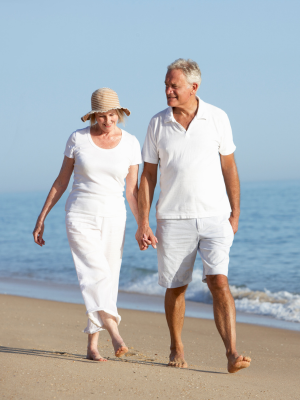Ageing Feet

Ageing is a fact of life. After your feet have carried you millions of kilometres through your life, they can eventually wear down. But there are ways to keep your feet healthy as you age – through proper maintenance, care and regular check-ups.
What happens to feet as they age?
As you age, you can lose cushioning and soft tissue fat in the pads of your heels and balls of your feet, near your toes. Like the skin on your face, there is also a loss of elasticity in the skin on your feet, making it thin and vulnerable.
Bone deformities – such as bunions or arthritis – and difficulties undertaking basic foot care, can lead to foot health issues and sometimes an increased risk of falls – which for many can have drastic consequences.
Nails also become more brittle, thicker and harder, making them difficult to trim and prone to ingrown toenails, fungal breakouts and other infections.
 |
Can foot problems be improved?For older people, most foot problems can be improved by regular maintenance and care, keeping weight down, shoe modification and use of cushioned insoles. To undertake regular foot maintenance, some elderly people have difficulty reaching their feet or have bad eyesight, so simple things like cutting toenails can be an issue – if this is the case get a family member to help or go and see a podiatrist. If you can cut your toenails yourself, make sure you trim them just short of the end of the toe, using a strong pair of nail clippers. After clipping, smooth the nails with a file or emery board, using downward strokes. It is also important to have your feet measured frequently as the bones in your feet change with age, this way you can ensure you choose shoes that fit well and are comfortable. |
Foot health tips
- Properly fitted shoes are essential. The older you get, the more you need shoes that hold your foot firmly in place and provide adequate support. Floppy favourites can make you unstable and should be thrown out as they can lead to falls.
- A shoe with a firm sole and soft upper that can be laced, buckled or strapped to the foot is best for daily activities.
- Walking is a good exercise option for most people’s feet.
- If you have reduced circulation, diabetes, or reduced fatty padding under your feet, avoid going barefoot even in your own home.
- Never cut corns and calluses with a razor, pocket knife, etc. Don’t use over-the-counter corn products unless they were recommended by your podiatrist as they may do more harm than good.
- Bathe your feet daily in lukewarm (not hot) water using a mild soap, then use a moisturiser separately.
- Trim or file your toenails so they are slightly curved just short of the end of the toe.
- Inspect your feet every day or have someone do it for you. If you notice any redness, cracks in the skin or sores, consult your podiatrist.
- Have your feet examined by a podiatrist at least once a year.
Mirrors of health
The condition of our feet often provides early indications of conditions such as diabetes, arthritis or
circulatory disease. For this reason, the human foot is sometimes called the ‘mirror of health’.
Look out for warning signs such as dry skin, brittle nails, burning and tingling sensations, cold feet, numbness, and discolouration. Seek the opinion of your podiatrist when any of these problems occur.
When should you see a podiatrist?
Regular check-ups with your podiatrist are recommended, especially if you cannot look after your feet yourself and have no assistance. Nails that grow too long can become infected and if you are diabetic – which has a higher risk factor as we age – infection can lead to more serious illness.
Taking good care of your feet as you age is good for your foot health as it helps you stay active and mobile.
